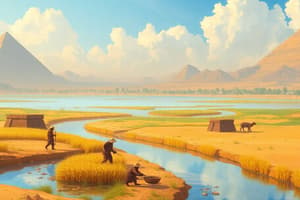Podcast
Questions and Answers
What natural phenomenon primarily contributed to the fertility of the Egyptian land along the Nile?
What natural phenomenon primarily contributed to the fertility of the Egyptian land along the Nile?
- Yearly flooding of the Nile (correct)
- Heavy winter snowfall
- Melting snow from the mountains
- Seasonal rains in the desert
How did the Egyptians perceive the Nile River in relation to their agriculture?
How did the Egyptians perceive the Nile River in relation to their agriculture?
- As a common river with no special significance
- As a god that provided life and abundance (correct)
- As a dangerous force that needed to be controlled
- As a boundary between different territories
What critical agricultural preparation did Egyptian peasants undertake after the Nile receded?
What critical agricultural preparation did Egyptian peasants undertake after the Nile receded?
- Harvesting crops immediately
- Preparing fields and irrigating crops (correct)
- Sowing seeds directly into dry soil
- Burning the fields for fertilizer
In what ways did the Nile differ from the rivers in Mesopotamia in terms of predictability for agriculture?
In what ways did the Nile differ from the rivers in Mesopotamia in terms of predictability for agriculture?
What term describes the rich black mud left behind by the Nile after flooding, which was crucial for farming?
What term describes the rich black mud left behind by the Nile after flooding, which was crucial for farming?
What symbol is commonly associated with King Scorpion according to historical evidence?
What symbol is commonly associated with King Scorpion according to historical evidence?
Which artifact is believed to celebrate the unification of Upper and Lower Egypt?
Which artifact is believed to celebrate the unification of Upper and Lower Egypt?
What was the significance of the double crown created by Narmer?
What was the significance of the double crown created by Narmer?
Which king is primarily credited with the unification of Upper and Lower Egypt?
Which king is primarily credited with the unification of Upper and Lower Egypt?
Around what time do scholars believe the unification of Egypt occurred?
Around what time do scholars believe the unification of Egypt occurred?
Flashcards are hidden until you start studying
Study Notes
The Gift of the Nile
- Yearly flooding of the Nile, caused by rains and snowmelt in East Africa, provided water and fertile silt for agriculture.
- Silt, a rich black mud, deposited in October after floods allowed crops like wheat and barley to thrive in otherwise dry conditions.
- Egyptians created a network of irrigation ditches to nurture their fields during fall and winter.
- The Nile was viewed as a deity that gave life; its reliability led to appreciation, as highlighted by Herodotus's phrase, "Egypt is the gift of the Nile."
Environmental Challenges
- Egyptian farmers experienced more predictable conditions than those in Mesopotamia, thanks to the regularity of the Nile compared to the Tigris and Euphrates.
- Nevertheless, living by the Nile still presented environmental risks.
Egyptian Kingdoms
- Farming villages existed in Egypt since around 5000 B.C. and included unique rituals and gods.
- By 3200 B.C., two kingdoms, Lower Egypt and Upper Egypt, had formed before unification.
- King Scorpion is suggested as an early king of Egypt, but more evidence supports King Narmer's role in the unification around 3000 B.C.
- Narmer created a double crown symbolizing the unity of the two kingdoms and established Memphis as the first capital of Egypt.
Mummification Practices
- Mummification involved extracting the brain, removing internal organs, treating the body with myrrh and natron, and wrapping it in cloth.
- The method described by Herodotus showcases Egyptians' understanding of the human body.
- Tombs were filled with goods for the afterlife, including clothing, food, and the Book of the Dead, which contained texts for the deceased's guidance in the afterlife.
Egyptian Writing
- Writing was crucial to Egyptian civilization, evolving from simple pictographs to a more complex system known as hieroglyphics.
- Hieroglyphics combined ideograms (representing ideas) and phonetic sounds, allowing a flexible form of communication.
- Egyptian scribes developed papyrus, providing a superior writing medium compared to stone and clay.
Prominent Invasions and Civilizations
- The Hyksos, rulers from Palestine, invaded Egypt around 1640 B.C. and controlled much of the country until 1523 B.C.
- The rise of the New Kingdom followed the Hyksos period, marking a time of significant power and glory for Egypt.
Conclusion
- The foundational role of the Nile, along with advancements in agriculture, writing, and burial practices, profoundly influenced Egyptian society, culture, and governance.
Studying That Suits You
Use AI to generate personalized quizzes and flashcards to suit your learning preferences.





